Coffee Basics
How to Clean Stains From Coffee Cups

Are your coffee cups plagued by stubborn stains that refuse to budge? Fear not, fellow caffeine enthusiasts! We’ve got the ultimate solution to bring your beloved mugs back to their sparkling glory.
With our tried and tested method, we’ll guide you through each step, from pre-treating the stains to soaking them in a powerful cleaning solution.
Get ready to bid farewell to those pesky coffee stains and enjoy sipping your favorite brew from a pristine cup once again.
Let’s dive in!
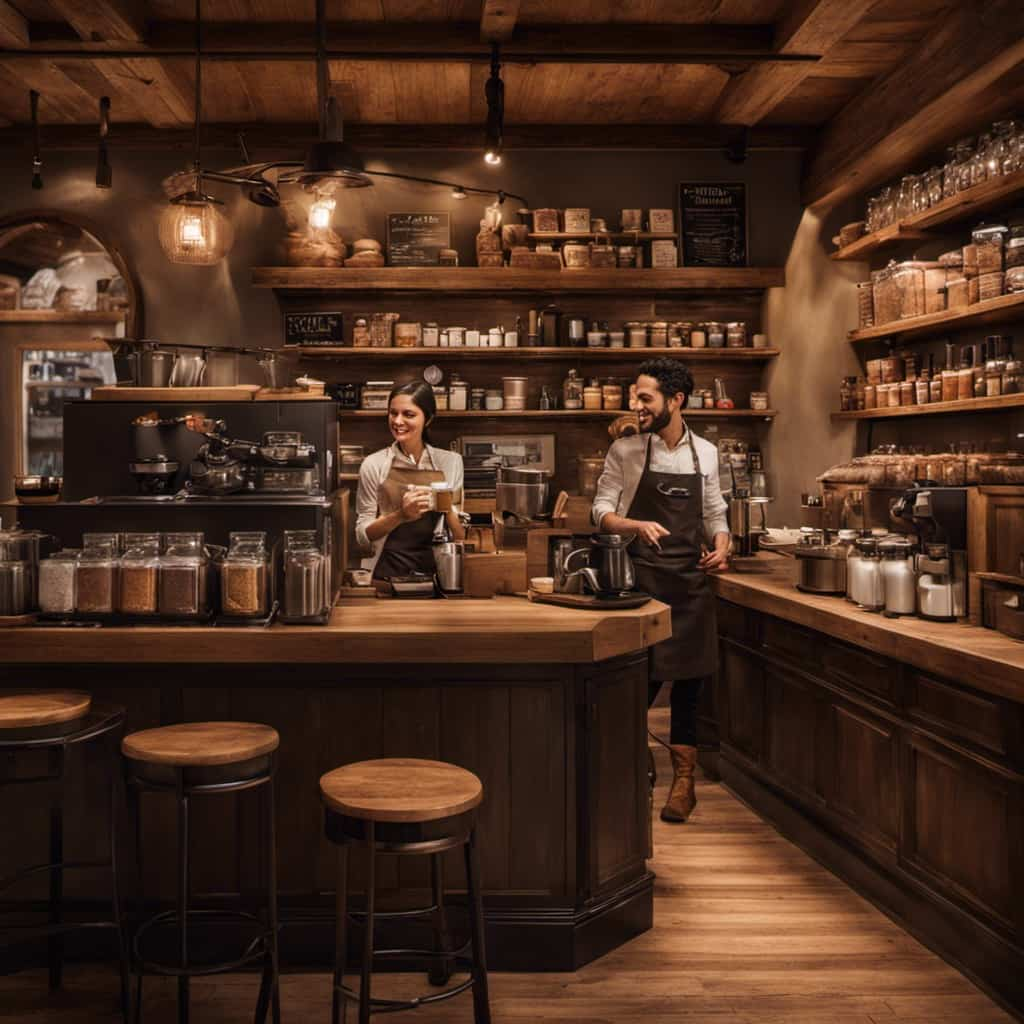
Key Takeaways
- Pre-treating stains with baking soda and water mixture, vinegar and salt combination, or lemon juice as a natural bleach can effectively remove coffee cup stains.
- Scrubbing with a gentle abrasive like baking soda paste or salt on a damp cloth or sponge can help to remove stubborn stains.
- Soaking coffee cups in a suitable cleaning solution, preferably a natural one, can help to loosen residue and deep-set stains.
- Thoroughly rinsing the cups with hot water, using a gentle scrub brush or sponge, and drying them completely can prevent water spots or residue buildup.
Gather Necessary Supplies
What supplies do we need to gather in order to clean stains from coffee cups?
When it comes to effectively cleaning coffee cup stains, it’s essential to have the right tools at hand. Firstly, we’ll need a mild dish soap or detergent, as well as a soft sponge or brush to scrub away the stains without causing any damage to the cup’s surface.
Additionally, having white vinegar or baking soda on hand can be beneficial for tackling stubborn stains. For those hard-to-reach areas, a narrow bottle brush can come in handy.
Lastly, it’s important to have a clean, lint-free cloth or towel to dry the cups after cleaning.

Pre-Treat the Stains
To pre-treat the stains on coffee cups, we will need to gather the necessary supplies. One of the most effective stain removal techniques is to use a mixture of baking soda and water. This natural remedy for coffee cup stains helps to break down the residue and remove the discoloration. Another option is to use a combination of vinegar and salt, which can help to lift the stains and eliminate any lingering odors. Additionally, lemon juice can be used as a natural bleach to lighten the stains. To pre-treat the stains, simply apply the mixture to the affected area and let it sit for a few minutes before scrubbing with a soft sponge or cloth. The table below summarizes these effective stain removal techniques:
| Technique | Ingredients |
|---|---|
| Baking Soda and Water | Baking soda, water |
| Vinegar and Salt | Vinegar, salt |
| Lemon Juice | Lemon juice |
Scrub With a Gentle Abrasive
Now let’s move on to scrubbing the coffee cups with a gentle abrasive.
Scrubbing techniques are essential to remove stubborn stains and residue from your coffee cups effectively. When choosing the right cleaning products, opt for gentle abrasives like baking soda, salt, or a soft-bristle brush.
Baking soda is known for its mild abrasive properties, making it ideal for tackling tough stains without scratching the surface of your cups. Simply create a paste by mixing baking soda with water, apply it to the stained areas, and gently scrub in circular motions.

Salt can also be used as a gentle abrasive by sprinkling it on a damp cloth or sponge and scrubbing the stains away. Remember to rinse the cups thoroughly after scrubbing to remove any residue and enjoy your freshly cleaned coffee cups.
Soak in a Cleaning Solution
We recommend soaking the coffee cups in a suitable cleaning solution. Soaking is an effective method to tackle stubborn stains and remove them easily.
There are alternative cleaning methods available, but soaking provides numerous benefits, especially when using natural cleaning solutions. Natural cleaning solutions are free from harsh chemicals, making them safer for both you and the environment. They’re also gentle on the surface of the coffee cups, preventing any damage or discoloration.
Soaking allows the cleaning solution to penetrate deep into the stains, breaking them down and making them easier to remove. It also helps to loosen any residue or buildup that may be present in the cups.

Rinse and Dry Thoroughly
After soaking the coffee cups in a cleaning solution, it’s important to thoroughly rinse and dry them.
Rinsing with hot water is crucial for removing any remaining residue and ensuring a clean and stain-free cup. Hot water helps to dissolve oils and coffee stains more effectively than cold water, making it an essential step in the cleaning process.
It’s recommended to use a gentle scrub brush or sponge to remove any stubborn stains that may still be present. Different types of coffee stains may require different removal methods. For example, for mild stains, a simple rinse with hot water and a gentle scrub may be sufficient. However, for more stubborn stains, a mixture of baking soda and water can be used as a paste to gently scrub the stains away.
Once the cups have been thoroughly rinsed, it’s important to dry them completely to prevent any water spots or residue from forming. Using a clean and dry towel, gently pat the cups dry or leave them in a dish rack to air dry.

Frequently Asked Questions
Can I Use Bleach to Remove Coffee Stains From My Cups?
Using bleach for coffee stains is effective, but it may leave a strong odor. We recommend trying alternatives like baking soda or vinegar. They are natural and can remove stains without the harsh smell.
How Long Should I Soak the Cups in the Cleaning Solution?
When cleaning coffee cups, it’s important to consider the soaking time needed for effective stain removal. Additionally, exploring alternative cleaning methods can be helpful in achieving optimal results.
Can I Use a Dishwasher Instead of Hand Washing to Remove Coffee Stains?
Using a dishwasher instead of hand washing can be effective in removing coffee stains. It’s important to choose a dishwasher with a strong cleaning cycle and use a detergent that is designed to remove stains.
What Should I Do if the Stains Are Still Visible After Following These Steps?
If the stains are still visible, it’s frustrating. We’ve tried everything, but sometimes stubborn stains need alternative cleaning methods. Here are some tips to prevent coffee stains in the first place.

Can I Use Vinegar as a Cleaning Solution to Remove Coffee Stains From My Cups?
Yes, vinegar can be used as an alternative cleaning solution to remove coffee stains from cups. However, to prevent stains in the first place, rinse cups immediately after use and consider using a coating product.
Conclusion
So there you have it, folks! With just a few simple steps, you can bid adieu to those stubborn coffee stains on your beloved cups.
Armed with the right supplies and a little elbow grease, you’ll be amazed at how pristine your cups can look once again.
Don’t let those unsightly stains dampen your coffee-drinking experience. Take charge, show those stains who’s boss, and sip your java in style.

Cheers to clean cups and a stain-free coffee journey!
Justin is a seasoned author, coffee and tea enthusiast, and an essential member of the Cappuccino Oracle team. With a keen appreciation for the complexities of coffee, coffee alternatives, and tea, Justin has dedicated his professional career to exploring these realms and sharing his insights with readers worldwide.
Justin’s immersion in the world of coffee, coffee alternatives, and tea began at a young age, kindling a passion that extended beyond mere consumption. This love for these beverages led him to combine his talent for writing with his devotion to coffee and tea, bringing him to Cappuccino Oracle as a dedicated author.
Coffee Basics
Alternative Milk Options for Your Coffee: Taste and Nutrition Comparison
You’ll discover the best alternative milk options for coffee, but which one truly enhances flavor and nutrition? Find out now!

When choosing alternative milk for your coffee, consider taste and nutrition. Oat milk stands out for its creamy texture and mild sweetness, plus it packs fiber and antioxidants. Almond milk has a distinctive nutty flavor, but it can separate in coffee and may leave a bitter aftertaste. Soy milk offers high protein content and a texture similar to cow's milk. Each option has its benefits, so think about what suits your taste and dietary needs best. If you're curious about how these alternatives stack up in different coffee types, you'll discover more insights soon.
Key Takeaways
- Oat milk offers a creamy texture and mild sweetness, enhancing coffee without overpowering its flavor, making it ideal for lattes and cappuccinos.
- Almond milk has a distinctive nutty flavor that can overshadow coffee notes, and may leave a bitter aftertaste in some blends.
- Nutritionally, oat milk contains 40-50 calories, 3-4g fiber, and more vitamins and minerals compared to almond milk, which has lower protein and calories.
- Soy milk provides high protein content similar to cow's milk, making it a good option for those seeking a protein boost in their coffee.
- Oat milk is preferred for its environmental benefits and lower greenhouse gas emissions, appealing to consumers focused on sustainability.
Overview of Alternative Milks
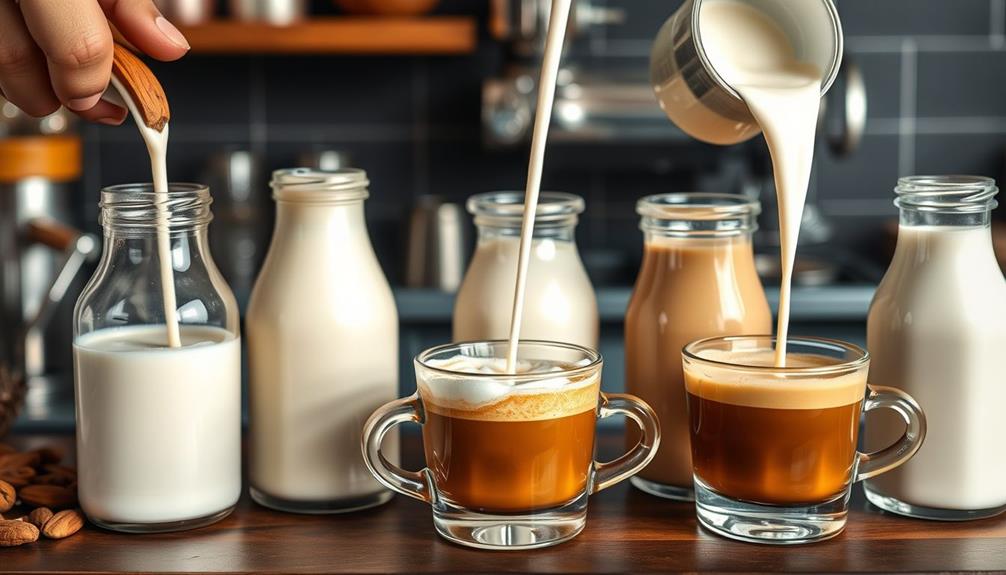
When exploring the world of alternative milks, you'll find a diverse range of options that cater to various tastes and dietary needs. Oat milk stands out for its creamy texture and nutrition, offering about 40-50 calories per cup and 3-4 grams of fiber. Its high levels of antioxidants also contribute to overall health, making it a popular choice for many.
If you prefer a lighter option, almond milk is a great choice. With 45-60 calories per cup, it features a distinct nutty flavor and is often fortified with calcium and vitamin D, although it has less protein than oat milk. Some individuals may experience gastrointestinal issues from certain alternative milks, so it's good to be mindful of how your body reacts to these options potentials for gastrointestinal discomfort.
Soy milk is another popular alternative, known for its high protein content and similarity to cow's milk, making it excellent for frothing in coffee beverages. Coconut milk provides a thick, creamy texture with a subtle coconut flavor, while rice milk offers a neutral taste but lacks calcium and protein, which can make it less ideal for coffee.
For unique nutritional benefits, consider hemp and pea milk. Hemp milk is rich in omega fatty acids, promoting heart health, while pea milk is high in protein, catering to those looking for substantial nutrition. Each alternative presents its own advantages, allowing you to choose what fits your lifestyle best.
Nutritional Comparison: Oat Vs Almond

Oat and almond milk each bring unique nutritional profiles to the table, making them popular choices for coffee lovers.
When you compare the two, oat milk generally has 40-50 calories per cup, while almond milk ranges from 45-60 calories per cup. If you're watching your calorie and fat content, oat milk stands out with just 2g of fat compared to almond milk's 2-3g. Oat milk also boasts 3-4g of fiber, which can help you feel fuller longer. Additionally, incorporating natural remedies for better health can enhance your overall wellness while enjoying these milk alternatives.
On the other hand, almond milk is lower in protein, offering only about 1g per cup, while oat milk provides 2-3g. If you're looking for vitamins and minerals, oat milk shines thanks to its higher levels of manganese, phosphorus, and vitamins B1, B2, and B12.
Additionally, oat milk tends to have a cleaner label with simpler ingredients, while almond milk may contain additives.
Ultimately, both nondairy milks have their benefits, and your choice may depend on your nutritional goals. Whether you prefer the fiber-rich oat milk or the calcium-fortified almond milk, each option complements your coffee in its own way.
Taste Profiles in Coffee

When you consider oat milk in your coffee, you'll notice its creamy texture and subtly sweet flavor that complements the coffee's natural notes.
This alternative milk has gained popularity among coffee lovers due to its ability to create a rich, frothy texture perfect for lattes and cappuccinos, enhancing the overall brewing experience through various brewing methods.
In contrast, almond milk introduces a stronger, nutty taste that can sometimes overshadow the coffee, leaving a bitter aftertaste.
Understanding these flavor profiles can help you choose the best milk for your perfect cup.
Oat Milk Flavor Profile
Blending seamlessly with your favorite coffee, oat milk offers a lightly sweet flavor profile that enhances the drink's natural notes without overwhelming them. Its creamy texture and rich mouthfeel make it a fantastic option for lattes and cappuccinos, allowing you to enjoy a velvety experience with every sip.
Additionally, oat milk is a great choice for those looking to incorporate more fiber into their diet, as it provides health benefits similar to essential oils for respiratory health that promote overall well-being.
When you choose oat milk, you're not just opting for a delicious non-dairy beverage; you're also benefiting nutritionally. With 2-3 grams of protein per cup, it helps create a stable foam that elevates your coffee drinks. Plus, at just 40-50 calories per cup, oat milk is a lighter choice compared to many other plant-based alternatives.
One of the standout features of oat milk is its fiber content, offering 3-4 grams per cup. This adds to its overall nutrition, providing health benefits that some other non-dairy options simply don't provide.
Almond Milk Characteristics
Although almond milk can add a distinctive nutty flavor to your coffee, its strong aftertaste may overpower the nuances of certain blends, particularly darker roasts. If you enjoy a lighter roast or flavored coffee, almond milk can enhance those profiles without overwhelming them.
Typically low in calories, almond milk ranges from 45 to 60 calories per cup, making it an appealing choice for those watching their intake. However, it contains only about 1g of protein, which is lower compared to other alternative milks. Additionally, coffee enthusiasts are encouraged to explore various milk alternatives to find the best match for their favorite brews, as different options can greatly alter the overall taste and enjoyment of the coffee unique flavor profiles.
When you add almond milk to your coffee, you might notice some visible separation, affecting the overall aesthetic and texture of your drink. This separation can be unappealing for some coffee enthusiasts.
Additionally, almond milk can introduce a slightly bitter taste, especially when compared to the creamier texture of oat milk. The emulsifiers in almond milk may also irritate the gut for some individuals, which could influence your preference for this alternative in coffee drinks.
Ultimately, if you're looking for a nutty twist in your coffee, almond milk could be a great option, but be mindful of its potential drawbacks.
Popular Brands of Alternative Milks
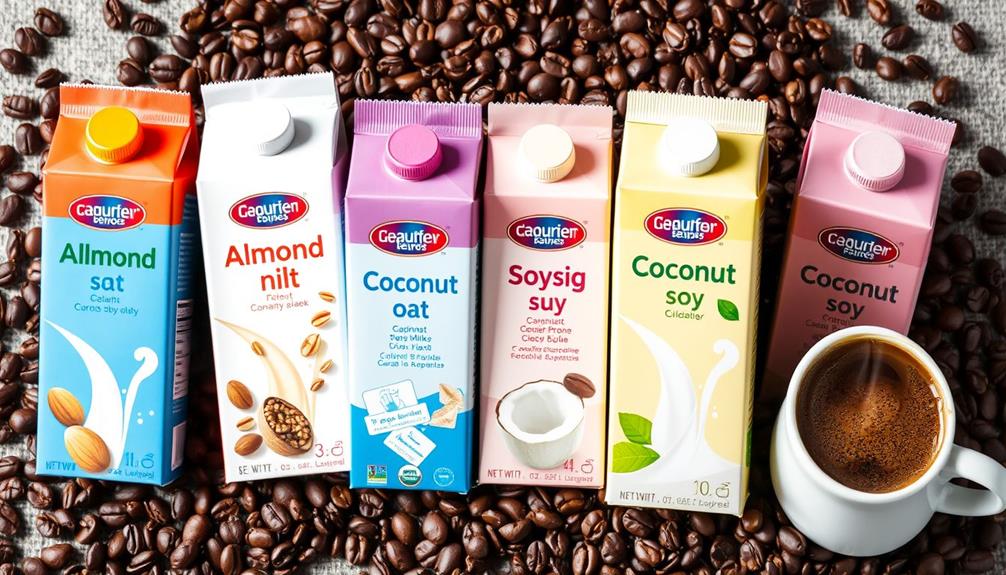
When you're exploring alternative milks for your coffee, you'll want to know the top brands in the game. Oatly and Planet Oat lead the oat milk market, while Blue Diamond Almond Breeze and Silk Original are strong contenders in the almond milk category.
Each offers unique nutritional profiles, so it's worth comparing them to find your perfect match. Additionally, using alternative milks can enhance your coffee experience by adding different flavors and textures, making it a delightful choice for many.
For those interested in health benefits, certain alternative milks can also provide nutritional advantages that support your overall well-being.
Leading Oat Milk Brands
Oat milk has surged in popularity as a creamy, plant-based alternative for coffee lovers, with several standout brands leading the charge.
Butter can enhance the texture of various dishes, and oat milk is no different when it comes to creating a velvety coffee experience.
If you're exploring oat milk options, here are four top contenders you should consider:
- Oatly Original: This brand contains 80 calories, 4.5g fat, 1g protein, and 2g sugar per cup, making it a beloved choice for its rich texture.
- Planet Oat Original: Offering similar nutrition, it also has 80 calories, 4g fat, 1g protein, and 2g sugar per cup, appealing to those who want versatility.
- Blue Diamond Almond Breeze: Though not oat milk, it's important to note as a dairy milk alternative with only 60 calories, 2.5g fat, 1g protein, and 2g sugar per cup.
- Silk Original Almond Milk: Another almond option, it provides 80 calories, 3.5g fat, 2g protein, and 3g sugar per cup, catering to those preferring nut-based options.
These oat milk brands like Oatly and Planet Oat are often noted for their cleaner labels, making them a great choice among plant-based milk alternatives.
Top Almond Milk Choices
In recent years, almond milk has emerged as a popular choice among coffee enthusiasts seeking a dairy alternative. If you're looking for lower-calorie options, Blue Diamond Almond Breeze stands out with just 60 calories per cup, 2.5g of fat, and 1g of protein. It's perfect for those who want to enjoy their coffee drinks without the extra calories.
Additionally, many brands of almond milk are fortified with essential nutrients, which can be beneficial for overall health, similar to how air quality considerations can impact one's well-being.
Silk Original Almond Milk offers a creamy texture that many love, with 80 calories per cup, 3.5g of fat, and 2g of protein. If you want a brand that froths well for lattes, Califia Farms' barista blend provides that rich, creamy consistency you crave.
For those who prefer organic ingredients, So Delicious Almond Milk offers a variety of flavors while remaining a lower-calorie option.
Remember, most almond milks are fortified with calcium and vitamin D, but be sure to check for added sugars and emulsifiers in the labels, as they can affect your overall health.
No matter your preference, these top almond milk choices can enhance your coffee experience!
Environmental Impact of Milk Options
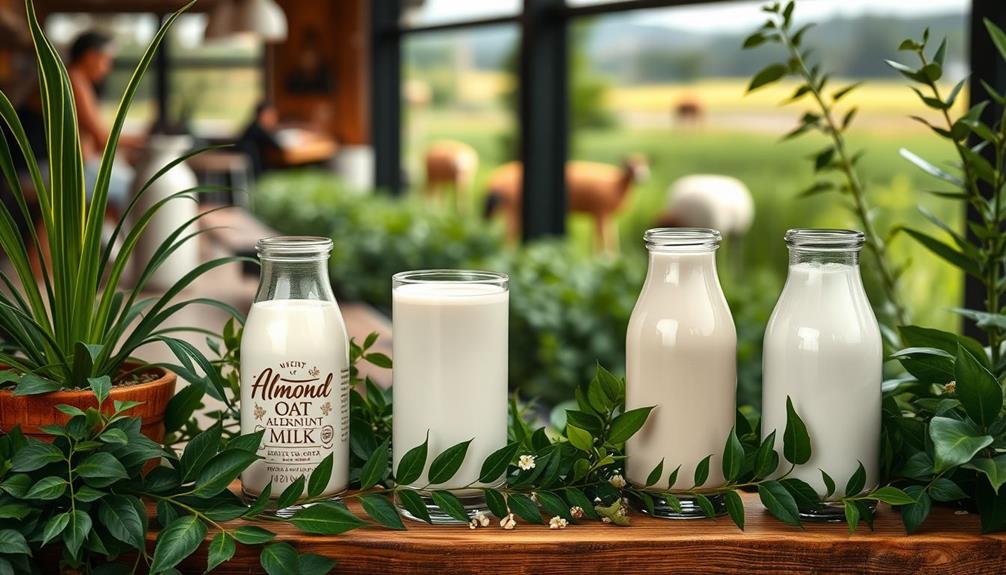
Sustainability plays an essential role in our choices regarding milk alternatives, especially as awareness of environmental impacts grows. Different plant-based milks come with varying levels of environmental consequences. Here's a quick comparison to evaluate:
- Oat Milk: Generally has a lower environmental impact, requiring less land and water when sourced sustainably. Additionally, choosing sustainable options can align with your personal financial goals, as it may help reduce costs associated with resource-intensive products, such as budgeting for sustainable choices.
- Almond Milk: Production is resource-intensive, using about 1.1 gallons of water per almond, which raises concerns about water scarcity.
- Soy and Oat Milks: Both contribute less to greenhouse gas emissions compared to dairy, making them more eco-friendly options.
- Rice Milk: Its production releases methane, a potent greenhouse gas, emphasizing the need for sustainable farming practices to mitigate this issue.
Choosing the right milk alternative isn't just about taste; it's about understanding the environmental impact of your choices. By opting for options like oat milk or sustainably sourced soy milk, you can reduce resource depletion and support better farming methods.
Being mindful of these factors helps promote a more sustainable future for our planet while enjoying your coffee.
Consumer Preferences and Trends

As consumers become more health-conscious and environmentally aware, their preferences for milk alternatives in coffee are rapidly evolving. The demand for plant-based milk alternatives, like oat and almond milk, is surging, driven by health concerns and dietary choices. Social media plays a significant role in shaping these consumer preferences, encouraging experimentation with various non-dairy milks in coffee beverages.
Here's a quick comparison of popular non-dairy options based on taste and texture:
| Non-Dairy Milk | Flavor Profile |
|---|---|
| Oat Milk | Creamy, mild sweetness |
| Almond Milk | Nutty, slightly sweet |
| Soy Milk | Creamy, earthy flavor |
| Coconut Milk | Tropical, sweet |
| Cashew Milk | Rich, buttery |
Oat milk stands out in taste testing, often favored for its creamy texture and ability to enhance coffee's flavor without overpowering it. As more consumers prioritize sustainability, the shift away from traditional dairy products continues to grow. Ultimately, your choice of milk alternative can reflect not just taste, but also a commitment to healthier and more sustainable living.
Health Considerations for Milk Alternatives
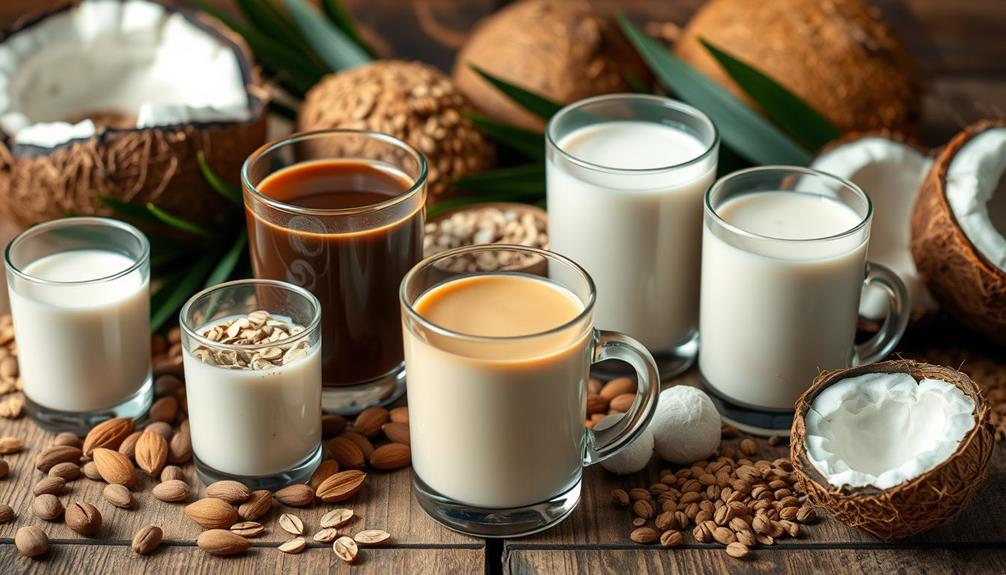
Choosing the right milk alternative for your coffee goes beyond personal taste; it also involves understanding the health implications of these options. Each alternative offers distinct nutritional benefits, but some may fall short in crucial nutrients found in traditional cow's milk. Individuals with certain health conditions, such as BPD symptoms, may find that particular milk alternatives support their emotional wellbeing better than others.
Here are key health considerations to keep in mind:
- Protein Content: Soy milk is high in protein, comparable to cow's milk, making it a great choice for those needing adequate protein intake without dairy.
- Calcium and Fortification: Unsweetened almond milk is often fortified with calcium and vitamin D, enhancing its nutritional profile and helping to promote bone health.
- Heart Health: Oat milk contains beta-glucans that can help lower cholesterol levels, providing a heart-healthy option compared to some other milk alternatives.
- Antioxidants: Almond milk is rich in vitamin E, offering antioxidants that may support heart health and skin vitality.
As you explore these alternatives, consider the nutritional profiles carefully, especially if you're looking for crucial amino acids and protein. Choosing fortified varieties can help guarantee you meet your nutritional needs while enjoying your coffee.
Recommendations for Coffee Lovers

For coffee lovers, the quest for the perfect milk alternative can enhance not just the flavor but also the overall experience of your favorite brew. If you're looking for a non-dairy option that balances taste and nutrition, unsweetened oat milk is your best bet. Its creaminess complements coffee beautifully, elevating the flavors without overpowering them. In contrast, almond milk offers a nutty flavor but may not blend as smoothly.
Here's a quick comparison to help you decide:
| Milk Type | Taste | Nutrition |
|---|---|---|
| Unsweetened Oat | Creamy, subtle | Higher fiber, lower calories |
| Almond Milk | Nutty, distinct | Higher protein, calcium, lower sugar |
| Overall Ranking | 1st | 2nd |
Choosing oat milk aligns you with health-conscious choices while providing a richer mouthfeel. If you're aiming for lighter beverages, oat milk's lower fat content is ideal. Although almond milk is lower in calories, its stronger flavor can overwhelm delicate coffee profiles. For a delightful coffee experience, make unsweetened oat milk your go-to alternative.
Frequently Asked Questions
Which Milk Alternative Tastes Most Like Milk in Coffee?
When you're looking for a milk alternative that tastes most like milk in coffee, oat milk's creamy texture and mild sweetness often make it your best choice, enhancing flavors without overpowering them.
What Is the Healthiest Milk to Put in Your Coffee?
When you're seeking the healthiest companion for your coffee, oat milk shines brightly. Its lower calories and higher fiber content nurture your body, making each sip a delightful blend of taste and nutrition you can appreciate.
Which Milk Alternative Is Best Taste?
When you're choosing a milk alternative for taste, you'll likely find oat milk provides a creamy, rich flavor that enhances coffee. Almond milk offers a nutty profile, but it can sometimes taste bitter.
Does Almond Milk or Oat Milk Taste Better in Coffee?
Oh, the great debate! If you savor smoothness and sweetness, oat milk's your best buddy in coffee. But if you fancy a nutty punch that might bite back, almond milk's got your back—just don't say I didn't warn you!
Conclusion
So, you've explored the world of alternative milks and discovered that choosing the right one for your coffee isn't just about taste or nutrition—it's about saving the planet, too. Ironically, while you sip your oat latte, you might find yourself pondering the environmental impact of that humble oat compared to your once-beloved dairy. Who knew your morning brew could spark such a deep existential crisis? Enjoy the journey, and remember, it's all about balance—just like your perfect cup of coffee!
In the vast and diverse world of coffee, coffee alternatives, and tea, Olivia has found her calling. As an author and a dedicated coffee and tea aficionado, her work for Cappuccino Oracle reflects her profound love and understanding of the intricate complexities found within these beverages. Olivia’s passion for the subject serves as both a catalyst for her creativity and a connection point with her audience.
Olivia’s appreciation for coffee, coffee alternatives, and tea blossomed at an early age. She discovered that these beverages invigorated her senses and stimulated her creative spirit. From the nuanced flavors of single-origin roasts to the captivating narratives intertwined with coffee, coffee alternatives, and tea trade and culture, Olivia found an unlimited source of inspiration in her daily cup.
Her love for these beverages and her talent for storytelling eventually converged at Cappuccino Oracle. As an author, Olivia’s mission is to illuminate the intricate tapestry that makes up the world of coffee, coffee alternatives, and tea. Her articles span a diverse range of topics, encompassing everything from the unique flavors of different brews to the sociocultural history intertwined with their cultivation and consumption.
Coffee Basics
Nespresso Sustainability: Environmental Impact of Coffee Pods
In exploring Nespresso’s sustainability efforts, discover how their coffee pods aim to reshape environmental impact and what you can do to help.

Nespresso focuses on sustainability by using fully recyclable aluminum coffee pods, aiming for a circular economy by 2030. They've invested considerably in recycling programs, with over 10,000 collection points worldwide. While their current recycling rate is at 25%, you can easily help improve this by participating in their robust return initiatives. Nespresso's commitment to renewable energy and sustainable farming practices guarantees a lower environmental impact compared to traditional brewing methods. As they work towards better recycling and material innovations, you'll find more insights into their efforts and how you can contribute to sustainable coffee consumption.
Key Takeaways
- Nespresso aims to recycle 75% of its aluminum coffee capsules by 2025, currently recycling only 25%.
- The company has achieved carbon neutrality by 2022 through investments in recycling and sustainability initiatives.
- Nespresso's aluminum pods have a lower environmental impact than traditional espresso methods, with over 80% of production relying on renewable energy.
- Nespresso partners with Rainforest Alliance to ensure sustainable coffee sourcing and support over 100,000 farmers through fair pricing and community development.
- The company is innovating with reusable capsules and investing in recycling programs, while competitors lag in sustainability efforts.
Nespresso's Sustainability Initiatives
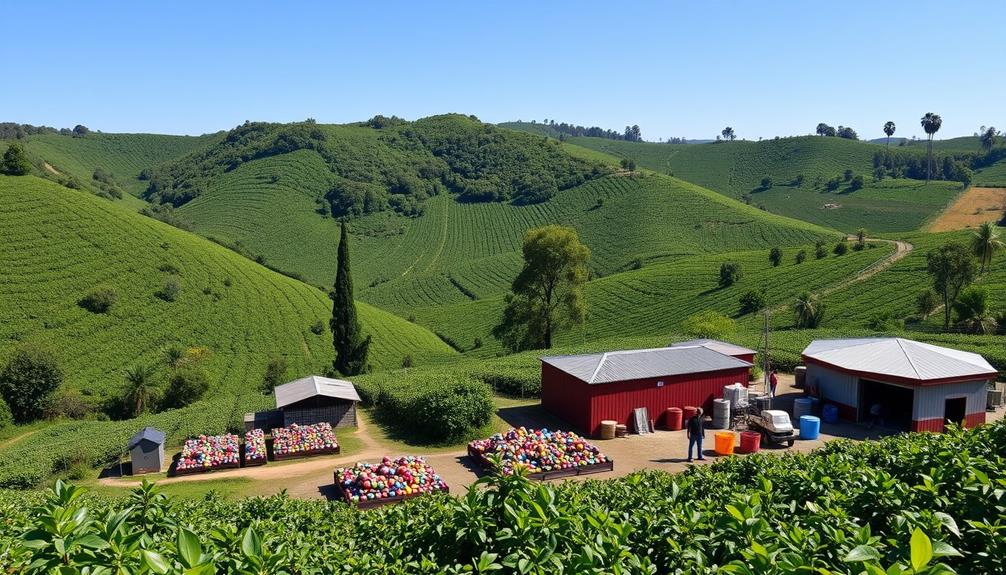
As Nespresso works to enhance its sustainability efforts, the company is making significant strides towards environmental responsibility and ethical sourcing. Since 2010, Nespresso has focused on using 100% recyclable aluminum coffee capsules, aiming to recycle 75% of them by 2025. With over 10,000 collection points globally, you'll find it easier than ever to participate in the recycling process.
Additionally, Nespresso's initiatives reflect an understanding of long-term capital appreciation and resilience, similar to how Gold IRAs provide a hedge against economic instability.
Nespresso's commitment goes beyond just recycling. The company has invested €500 million in sustainability programs since 2003, which not only enhance environmental practices but also support coffee farmers. Partnering with the Rainforest Alliance, Nespresso promotes sustainable coffee sourcing through its "AAA Sustainable Quality" program. This initiative guarantees that farmers adhere to high-quality and environmentally friendly practices, benefiting both the planet and the producers.
Additionally, the Nespresso Sustainability Advisory Board provides expert guidance on these initiatives, reinforcing the importance of responsible sourcing and environmental stewardship.
Recycling Programs Overview

Nespresso's commitment to sustainability includes robust recycling programs designed to make it easy for you to recycle used coffee capsules. With over 10,000 collection points spread across the globe, you can easily find a location to drop off your used capsules.
If you don't have a collection point nearby, Nespresso offers a convenient mail-back recycling program, ensuring that everyone can participate in their recycling initiatives. Additionally, their focus on transparency and community involvement is reminiscent of various trusted investment options in the market, emphasizing the importance of consumer engagement.
By 2025, Nespresso aims to recycle 75% of used capsules, and they're actively working to raise awareness through educational campaigns on the importance of recycling. Each recycling bag provided by Nespresso can hold up to 200 Original or 100 Vertuo capsules, making it simple for you to gather and send them back.
The recycled aluminum from these capsules is then repurposed into products like pens and bikes, showcasing the potential of recycling. Despite these efforts, the current recycling rate for Nespresso capsules stands at only 25%, indicating that there's still work to be done in encouraging consumer participation.
Your involvement in the recycling program is vital for achieving a sustainable future.
Environmental Impact of Coffee Pods
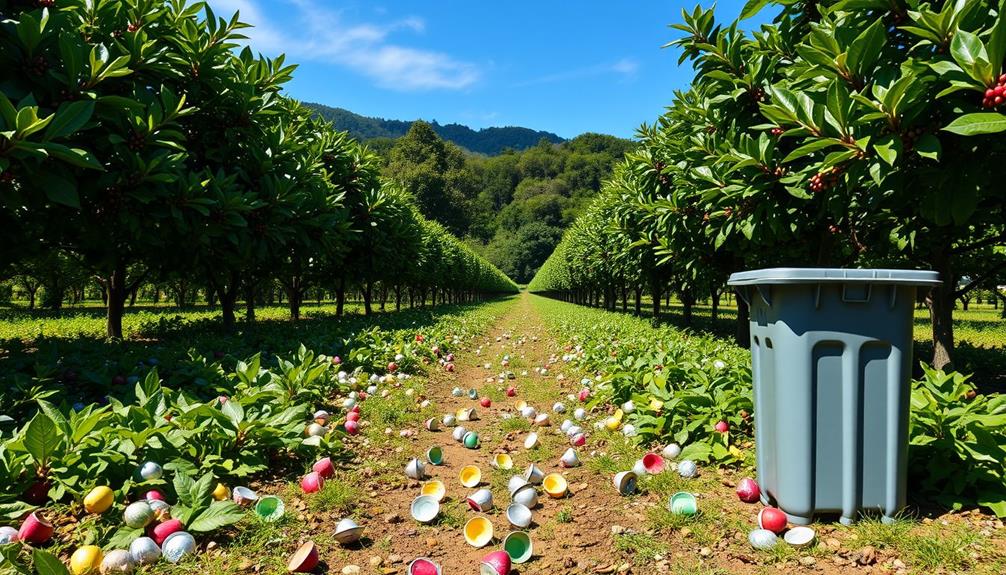
You mightn't realize how your coffee capsule choices affect the environment.
While Nespresso offers recyclable aluminum pods, the challenge lies in consumer participation in recycling programs.
Understanding the benefits of choosing the best heat pump can provide insights into making eco-friendly decisions.
Recycling Challenges and Solutions
The recycling challenges surrounding coffee pods are significant, with only 25% of Nespresso's capsules currently being recycled. This low rate highlights issues in consumer participation and convenience. The aluminum capsules require specialized recycling processes due to their silicon lining, which is why Nespresso has set up over 10,000 collection points worldwide.
Additionally, the potential environmental impact of improper disposal of these pods is comparable to other waste challenges, as seen with cold medications that also require careful consideration regarding recycling and waste management. However, this effort often falls short because many coffee drinkers don't empty their capsules before returning them for processing.
Nespresso does offer free return bags for used capsules, capable of holding up to 200 Original or 100 Vertuo capsules, yet many consumers either remain unaware of this option or are reluctant to use it. This behavior complicates recycling initiatives and contributes to the environmental impact of coffee pods.
With approximately 39,000 capsules produced every minute, around 29,000 end up in landfills each minute, exacerbating waste issues.
To improve recycling rates, educating consumers about the importance of proper disposal and making the process more convenient could make a significant difference. By actively participating in recycling efforts, you can help reduce the environmental footprint of coffee pods.
Lifecycle Assessment Considerations
Recycling challenges are only part of the environmental impact puzzle when it comes to coffee pods. When you consider lifecycle assessments, you'll find that Nespresso's aluminum pods actually have a lower environmental impact compared to traditional espresso brewing methods. This is largely due to their efficient use of coffee and reduced waste, as well as their ability to minimize coffee grounds in the final cup, leading to a smoother brewing experience.
Nespresso aims for a 75% recycling rate for used capsules by 2025, showing their commitment to minimizing their environmental footprint. Various brewing methods affect caffeine content considerably, demonstrating the importance of resource management in the coffee industry.
While the production of coffee pods does generate considerable greenhouse gas emissions, Nespresso's shift to 100% recyclable aluminum since 2010 has enhanced the sustainability of their packaging. Studies reveal that, although instant coffee boasts the lowest environmental impact, coffee capsules still outperform traditional brewing methods regarding waste and resource management.
Additionally, over 80% of Nespresso's production relies on renewable energy sources, and they've made ongoing investments in recycling initiatives, working towards their goal of carbon neutrality by 2022.
Economic Contributions to Coffee Farmers

Nespresso's commitment to supporting coffee farmers is making a significant impact on their economic well-being. By providing fair pricing and training, Nespresso is enhancing the livelihoods of over 100,000 coffee farmers. This support not only improves their farming practices but also stabilizes their income, thanks to the company's direct trade model. This approach guarantees fair compensation, fostering community development and resilience within coffee farming communities worldwide. Additionally, regulatory compliance in their sourcing practices guarantees that the benefits reach the farmers effectively.
Furthermore, Nespresso invests in local infrastructure projects, which improve living conditions and create economic opportunities for these farmers. Through its "AAA Sustainable Quality" program, Nespresso guarantees that farmers produce consistent, high-quality coffee beans while promoting sustainable farming practices. This initiative is essential in guaranteeing both environmental sustainability and economic viability.
Moreover, Nespresso's commitment to sustainable sourcing directly contributes to local economies, helping to uplift the communities that grow the coffee you enjoy. By choosing Nespresso's plastic capsules, you're not only savoring premium coffee but also supporting a system that values the farmers behind it. This creates a positive cycle of economic growth and sustainability for coffee farming communities.
Future Sustainability Goals

Aiming for a fully circular economy by 2030, Nespresso is setting ambitious sustainability goals that promise to reshape its operations and impact. You'll see a commitment to sustainable sourcing, with plans to include all coffee varieties by 2025. This shift not only promotes environmentally friendly practices but also enhances the entire supply chain.
Nespresso's dedication to carbon neutrality by 2022 demonstrates its focus on reducing emissions tied to coffee cultivation and production. Recycling efforts are ramping up, aiming for 75% of used capsules to be recycled by 2025 through over 10,000 global collection points and a mail-back program.
Here's a snapshot of Nespresso's future sustainability goals:
| Goal | Target Date |
|---|---|
| Full Circular Economy | 2030 |
| Sustainable Sourcing for All | 2025 |
| Carbon Neutrality | 2022 |
| 75% Recycling of Capsules | 2025 |
Convenience of Single-Cup Machines

Single-cup machines like Nespresso and Keurig make your morning routine a breeze.
With their user-friendly designs, these machines provide an array of coffee options to suit any taste preference, ensuring a delightful start to your day.
With just one button and easy capsule insertion, you can brew a fresh cup of coffee in no time.
This time-saving convenience is perfect for anyone juggling a busy lifestyle, similar to the ease of using best vacuums for dust removal for quick cleanups around the house.
Time-Saving Brewing Method
Many people appreciate the efficiency of single-cup coffee machines, which have become a staple in nearly half of American households. These machines, like Nespresso and Keurig, allow you to brew a perfect cup using convenient capsules, meaning you don't have to grind coffee or measure anything. This simplicity is a game changer for those with busy mornings.
Single-cup machines are designed for speed, making them ideal for your fast-paced lifestyle. You can enjoy a freshly brewed cup in just a couple of minutes, saving you time during your morning routine. Plus, cleanup is a breeze compared to traditional brewing methods.
Here's a quick comparison of single-cup machines:
| Feature | Single-Cup Machines | Traditional Brewing Methods |
|---|---|---|
| Brew Time | 1-2 minutes | 5-10 minutes |
| Cleanup | Minimal | Extensive |
| Capsule Options | Wide variety | Limited |
| Environmental Impact | Can be eco-friendly | Often less sustainable |
Ease of Use
With the rise of single-cup coffee machines, countless households have embraced the simplicity they offer. Nearly 50% of Americans now rely on these convenient devices for their daily caffeine fix. Nespresso and Keurig models stand out with their easy capsule insertion and one-button operation, making it a breeze for you to brew your favorite coffee.
The appeal of single-cup machines is further enhanced by the growing awareness of different brewing methods that cater to diverse coffee preferences.
The minimal cleanup required with single-cup machines is another significant advantage. Unlike traditional brewing methods that can leave you with a pile of dirty dishes, using coffee pods means you can enjoy a delicious cup without the hassle. This efficiency appeals to busy individuals like you, who want to streamline their morning routine.
Sales of coffee pod machines skyrocketed from 1.8 million in 2008 to 20.7 million in 2018, clearly demonstrating how much people value convenience. You can quickly prepare your coffee, sip it while getting ready, and be out the door in no time.
The ease of use of these machines has made them a staple in many kitchens, proving that simplicity and quality can go hand in hand in your daily coffee ritual.
Innovations in Capsule Materials
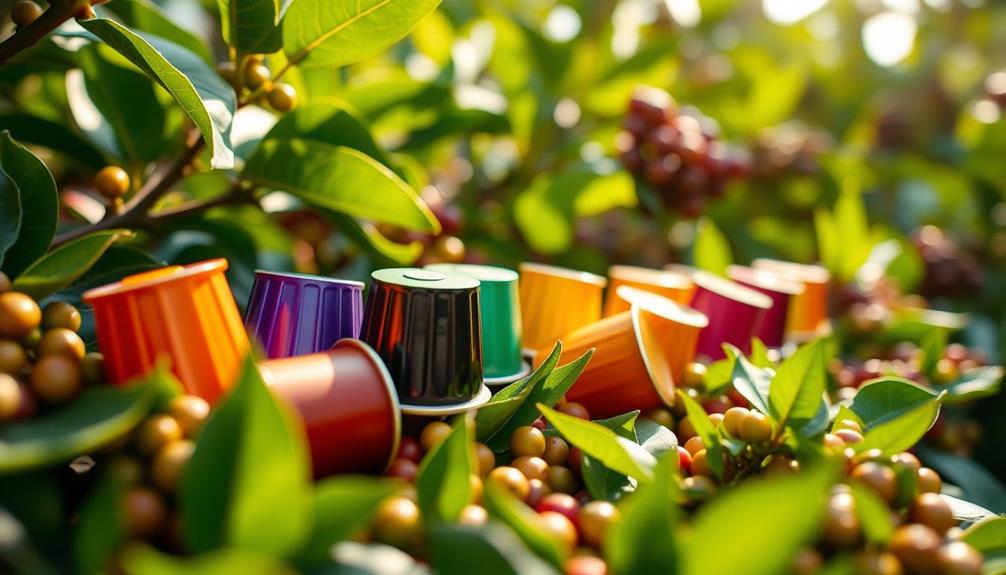
As the demand for sustainable coffee options grows, innovations in capsule materials are taking center stage. Companies like Lavazza are leading the charge with compostable coffee capsules, while Sendero Specialty Coffee creates capsules made from biopolymers that decompose within six months. This shift towards sustainable materials is essential in reducing the environmental footprint of coffee consumption.
Furthermore, understanding common financial terms related to investments can help consumers make informed choices about sustainable products, potentially influencing their purchasing decisions.
Nespresso has also made strides in this area, using fully-recyclable aluminum capsules since 2010. These capsules are designed to be returned for specialized recycling, markedly enhancing their sustainability efforts. In addition, Nespresso invests over €35 million annually to support pod recycling initiatives, demonstrating their commitment to innovative recycling solutions.
Research continues into developing sustainable, upcycled materials that can mimic coffee's properties, which could help minimize reliance on traditional sources and lessen environmental impacts.
Furthermore, the introduction of reusable capsules allows you to use your own coffee grounds, cutting down on waste generated by single-use plastic pods. By embracing these innovations, you can enjoy your coffee guilt-free, knowing you're contributing to a more sustainable future.
Nespresso Vs. Competitors

When you compare Nespresso to its competitors, you'll notice significant differences in recycling efforts and sustainability initiatives.
Nespresso's robust collection system and commitment to recycling aim for 75% of used capsules by 2025, while competitors like Keurig lag behind with lower recycling rates.
This focus on content relevance and authority further emphasizes Nespresso's structured approach to sustainability.
Understanding these distinctions helps you see how Nespresso's structured approach to sustainability sets it apart in the market.
Recycling Efforts Comparison
Recycling efforts in the coffee industry reveal stark contrasts between Nespresso and its competitors, particularly Keurig. Nespresso's commitment shines through with 100% recyclable aluminum capsules and over 10,000 collection points worldwide for used pods. You can easily return these capsules for recycling, and if you lack access to a collection point, Nespresso's mail-back program guarantees you can still participate in their recycling efforts.
Additionally, Nespresso emphasizes the importance of responsible investment choices, akin to protecting your savings by researching and supporting environmentally conscious companies.
On the other hand, Keurig's K-Cup pods are made from recyclable #5 plastic, but they require you to peel lids and separate components to recycle properly. This added step can discourage many consumers. While Keurig has launched a K-Cycle mail-back program aimed at offices, it falls short in accessibility for home users.
Despite Nespresso's extensive infrastructure, their recycling rate sits at only 25%, highlighting a gap in participation. Meanwhile, Keurig is actively working to improve the recycling process for their K-Cups.
Nespresso invests over €35 million annually in pod recycling initiatives, considerably outpacing Keurig's efforts, which have faced criticism for the environmental impact of their plastic pods.
Environmental Impact Analysis
Nespresso's focus on sustainability extends beyond its recycling programs, impacting the overall environmental footprint of its operations. By utilizing 100% recyclable aluminum capsules, Nespresso stands out against competitors like Keurig, which historically relied on difficult-to-recycle plastic for their K-Cups.
Although Keurig switched to recyclable #5 plastic in 2020, it still lags behind Nespresso's proactive measures. Nespresso has established over 10,000 collection points worldwide for used capsules, making it easier for you to recycle than with Keurig's more cumbersome process that requires peeling lids and disposing of grounds.
Nespresso's ambitious goal of achieving a 75% recycling rate for used capsules by 2025 starkly contrasts with Keurig's estimated rates of only 36% to 37%.
Furthermore, Nespresso's partnership with organizations like the Rainforest Alliance and its investment of over €500 million since 2003 in sustainability initiatives highlight its commitment to reducing greenhouse gas emissions and promoting sustainable coffee sourcing.
While many competitors are just beginning to address sustainability, Nespresso has long prioritized it, showcasing a genuine dedication to minimizing its environmental impact.
Sustainability Initiatives Overview
In the domain of sustainability initiatives, Nespresso sets a high bar for its competitors by committing to 100% recyclable aluminum capsules and establishing over 10,000 collection points worldwide for used capsules. This commitment aligns with Nespresso's goal to recycle 75% of its used capsules by 2025, addressing its carbon footprint effectively.
Here's a comparison of Nespresso and Keurig's sustainability initiatives:
| Feature | Nespresso | Keurig |
|---|---|---|
| Capsule Material | 100% recyclable aluminum | Recyclable #5 plastic |
| Current Recycling Rate | 25% | 36%-37% |
| Investment in Sustainability | €500 million since 2003 | K-Cycle mail-back program |
| Carbon Neutrality Goal | Achieved by 2022 | Regrets over K-Cup environmental impact |
Nespresso's AAA Sustainable Quality program supports over 100,000 coffee farmers, greatly enhancing its sustainability profile. In contrast, Keurig's founder acknowledges the need for better sustainability in coffee pod manufacturing. By prioritizing recyclable materials and thorough recycling solutions, Nespresso exemplifies a proactive approach to reducing its environmental impact.
Expert Recommendations on Machines
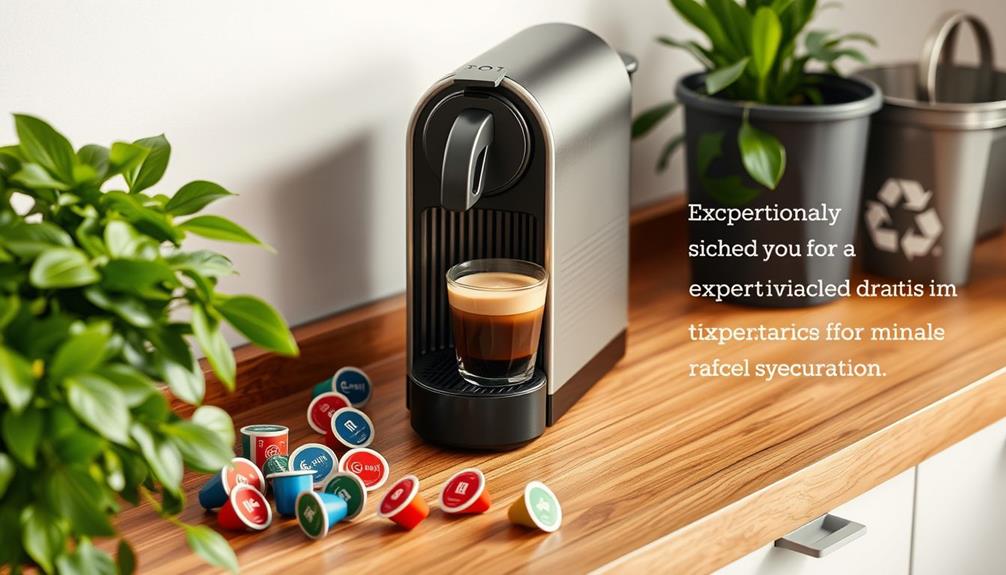
When it comes to brewing high-quality espresso, Nespresso machines come highly recommended by coffee experts for their efficiency and compact design. Models like the Essenza Mini stand out for their ability to deliver excellent coffee while taking up minimal counter space.
These coffee makers allow you to use the exact amount of coffee beans needed for each brew, which not only enhances flavor but also cuts down on waste.
Moreover, Nespresso's commitment to sustainability is evident in their use of 100% recyclable aluminum capsules. This approach greatly reduces the environmental impact compared to traditional coffee brewing methods that often generate more waste.
The Nespresso Sustainability Advisory Board provides expert guidance to continually enhance these practices, ensuring that the machines align with eco-friendly goals.
Investing in Nespresso machines means you're making a more sustainable choice in the coffee market. Their ongoing recycling programs, including free return bags for used capsules, further support this recommendation.
With Nespresso, you're not just enjoying a great cup of espresso; you're also actively participating in a movement toward reducing the carbon footprint associated with coffee preparation.
Climate Change and Coffee Production

Climate change is reshaping the landscape of coffee production, threatening the future of Arabica beans that many coffee lovers cherish. Projections suggest that by 2050, suitable growing areas for these delicate beans could shrink by 50% due to rising temperatures. This isn't just a problem for coffee enthusiasts; it's a pressing issue for farmers in regions like Ethiopia, where traditional cultivation methods may become unsustainable.
As the climate warms, agricultural losses could escalate, jeopardizing the livelihoods of those who depend on coffee production. However, there's hope on the horizon. Researchers in Costa Rica are exploring genetic modifications to develop coffee hybrids that can withstand climate change's challenges. These innovations aim to safeguard future coffee supplies.
The coffee industry is waking up to these realities, with companies like Nespresso investing in sustainable farming initiatives. By promoting sustainable practices, they're helping coffee farming communities adapt and thrive.
Given that up to 60% of coffee consumed globally is Arabica, immediate action is essential. Together, we can work towards a more resilient coffee future in the face of climate change.
Frequently Asked Questions
How Environmentally Friendly Are Nespresso Pods?
When you consider environmental friendliness, think about recycling and waste. Nespresso pods use recyclable aluminum, and the company's efforts to reduce carbon footprints and promote sustainability make them a more eco-conscious choice compared to traditional brewing methods.
Is Nespresso Coffee Sustainably Sourced?
Isn't it reassuring to know that Nespresso's coffee is sustainably sourced? They actively support over 100,000 farmers, invest in sustainability programs, and aim for full sustainable sourcing by 2025. You can sip responsibly!
Is Nespresso Not Eco Friendly?
You might think Nespresso isn't eco-friendly due to its coffee pod waste and specialized recycling challenges. While they've made progress, significant environmental concerns still exist, making it hard to label them truly sustainable.
Do Nespresso Really Recycle Their Pods?
You might wonder if Nespresso truly recycles their pods. Yes, they do. They've set up numerous collection points and offer mail-back programs, but many customers still don't utilize these options, leading to lower recycling rates.
Conclusion
In the grand tapestry of coffee culture, Nespresso's commitment to sustainability weaves a thread of hope amidst the challenges posed by climate change. By embracing recycling and innovative materials, they transform single-use pods into symbols of responsibility. As you sip your rich espresso, remember that every cup can symbolize not just indulgence, but also a step toward a greener future. Together, you can make a difference, ensuring that the aroma of coffee continues to fill the air for generations to come.
In the vast and diverse world of coffee, coffee alternatives, and tea, Olivia has found her calling. As an author and a dedicated coffee and tea aficionado, her work for Cappuccino Oracle reflects her profound love and understanding of the intricate complexities found within these beverages. Olivia’s passion for the subject serves as both a catalyst for her creativity and a connection point with her audience.
Olivia’s appreciation for coffee, coffee alternatives, and tea blossomed at an early age. She discovered that these beverages invigorated her senses and stimulated her creative spirit. From the nuanced flavors of single-origin roasts to the captivating narratives intertwined with coffee, coffee alternatives, and tea trade and culture, Olivia found an unlimited source of inspiration in her daily cup.
Her love for these beverages and her talent for storytelling eventually converged at Cappuccino Oracle. As an author, Olivia’s mission is to illuminate the intricate tapestry that makes up the world of coffee, coffee alternatives, and tea. Her articles span a diverse range of topics, encompassing everything from the unique flavors of different brews to the sociocultural history intertwined with their cultivation and consumption.
Coffee Basics
Baristas Hate This One Simple Coffee Hack
Keen to elevate your coffee experience? Discover why baristas dread this simple hack that transforms your drink’s flavor in ways you never imagined.

Baristas dread the simple coffee hack of shaking your drink instead of stirring it. When you shake coffee, it creates turbulent flow, leading to better flavor integration and distribution. This method enhances the taste by generating smaller vortices that promote quicker diffusion, leaving your drink rich and consistent. While gentle stirring might improve flavor slightly, it can't match the efficiency of shaking. Baristas know this and often prefer to educate customers on proper mixing techniques to elevate the overall experience. If you want to reveal even more secrets to upgrade your coffee game, there's so much more to explore!
Key Takeaways
- Shaking coffee drinks instead of stirring creates turbulence for better flavor integration, which can undermine baristas' traditional techniques.
- Using a lid while shaking prevents spills and maximizes flavor blending, challenging barista expertise in drink preparation.
- Customers who adopt shaking can enhance their coffee experience, reducing reliance on baristas for flavor nuances.
- Experimenting with shaking techniques may lead to unique flavor profiles, disrupting the consistency baristas strive for in their beverages.
- Baristas prefer established methods; this simple hack could diminish their control over flavor integration and drink quality.
The Science of Mixing

Mixing drinks, especially coffee, isn't just about tossing ingredients together; it's a science. When you pour your favorite brew, the liquids mix through diffusion, which relies heavily on the movement of molecules. Turbulent flow plays a vital role here, creating smaller vortices that promote quicker mixing.
To guarantee ideal results, consider factors like air quality indicators that can impact your overall drinking experience. But here's the catch: fast stirring doesn't necessarily enhance mixing efficiency. Instead, it can lead to laminar flow, producing larger vortices that slow down the diffusion process.
To enhance your drink, consider shaking it with a lid. This method generates even more turbulence than traditional stirring, allowing for better flavor distribution.
Understanding the difference between laminar and turbulent flow can help you refine your mixing techniques. By focusing on turbulence, you guarantee that the flavors in your coffee or tea blend seamlessly, enhancing your overall tasting experience.
Importance of Flavor Integration

Effective mixing is key to achieving proper flavor integration in your coffee. When you mix your coffee well, you guarantee that all the flavor compounds are evenly distributed, enhancing the overall taste experience. This process greatly impacts how you enjoy each sip, as the interaction of different taste compounds creates a harmonious blend.
Here's a quick overview of how different mixing techniques affect flavor integration:
| Mixing Technique | Flavor Integration Impact |
|---|---|
| Gentle stirring | Slight improvement in flavor |
| Shaking | Creates smaller vortices |
| Turbulent mixing | Rapid diffusion of flavors |
| Cold brew method | Gradual and smooth flavor release |
| Blending | Combines flavors effectively |
When you understand the importance of flavor integration, you can experiment with various mixing methods to find what works best for you. Baristas leverage this knowledge to enhance the quality of their beverages. By guaranteeing flavors are fully incorporated before serving, they elevate customer satisfaction and drink quality. So, next time you make coffee, think about how you're mixing it and the difference it can make!
Shaking vs. Stirring

When it comes to enhancing your coffee's flavor, the choice between shaking and stirring can make all the difference. Here's why you might want to shake it up:
- Turbulence Matters: Shaking creates more turbulence, which helps mix ingredients more efficiently than stirring. This method is similar to how different tea types can enhance flavors in food pairings, as certain teas can complement or mitigate spices.
- Flavor Distribution: Unlike stirring, which can lead to larger vortices, shaking guarantees that flavors are evenly distributed throughout your drink. For instance, just as caffeine content in tea varies across different types, the blending method can influence the final taste of your coffee.
- Faster Mixing: The chaotic nature of shaking allows for quicker diffusion of flavors, resulting in a more uniform taste.
Stirring might seem like the go-to method, but it often leads to laminar flow that doesn't blend flavors as effectively. Fast stirring doesn't greatly speed up mixing either.
In contrast, shaking utilizes turbulent flow, reducing molecular diffusion distances and promoting better flavor integration.
Baristas understand this principle, and by shaking beverages, they can elevate the quality of your drink and boost customer satisfaction.
If you're aiming for that perfect cup of coffee, consider shaking instead of stirring. You'll experience a richer, more harmonious blend of flavors that transforms your coffee ritual.
Understanding Flow Dynamics

Often overlooked, the principles of flow dynamics play a crucial role in how liquids interact and mix. Understanding these principles can help you take your coffee-making skills to the next level. There are two main types of flow: laminar and turbulent. Turbulent flow, characterized by chaotic and smaller vortices, promotes efficient mixing and molecular diffusion, while laminar flow maintains a more orderly flow, leading to slower mixing.
Your stirring techniques greatly impact the type of flow created. For instance, erratic stirring can create turbulence, while smooth, continuous stirring keeps it laminar. Notably, fast stirring isn't always the best method, as it can generate larger vortices that hinder rapid mixing.
Here's a quick overview:
| Flow Type | Characteristics |
|---|---|
| Laminar | Smooth, orderly, slower mixing |
| Turbulent | Chaotic, smaller vortices, faster mixing |
| Stirring Technique | Type of flow created |
| Mixing Efficiency | Varies based on flow dynamics |
Benefits of Turbulent Mixing

Turbulent mixing offers significant advantages that can elevate your coffee experience. When you understand the power of this technique, you'll notice a remarkable difference in flavor and consistency.
This method isn't only effective for coffee but can also enhance the infusion of flavors in beverages like herbal tea, where varieties include chamomile and peppermint that benefit from thorough mixing.
Here are three key benefits:
- Enhanced Flavor Diffusion: Turbulent mixing generates smaller vortices, allowing flavors to blend more quickly and effectively. This means you get a richer, more complex taste in every sip.
- Faster Mixing: Unlike laminar flow, which can slow things down, turbulent flow reduces the distance between molecules. This chaotic motion means your ingredients mix more thoroughly in less time, leading to a well-integrated beverage.
- Consistency in Every Cup: Shaking a drink with a lid increases turbulence, promoting uniformity. You can say goodbye to that occasional sip that tastes different from the last, ensuring every cup is just as delicious as the one before.
Practical Barista Techniques

Mastering practical barista techniques can transform your coffee-making skills and elevate the flavors of your beverages. One effective method is shaking coffee drinks with a lid. This technique creates turbulence, enhancing mixing and flavor integration far better than traditional stirring methods.
By utilizing turbulent flow, you'll produce smaller vortices that considerably reduce diffusion distances, allowing for quicker and more effective mixing of ingredients. Additionally, investing in quality espresso machines, such as the Breville Cafe Roma Espresso Maker, can further enhance your brewing experience, ensuring that the base of your drinks is first-rate.
Experimenting with various stirring techniques is key to discovering the ideal method for each coffee drink. Different beverages may require distinct approaches, and understanding the principles of laminar versus turbulent flow can help you select the right mixing technique.
For instance, a delicate espresso might benefit from gentle stirring, while a robust iced coffee could thrive when shaken.
Don't forget to educate your customers about the benefits of shaking drinks instead of simply stirring. Sharing this knowledge can enhance their overall experience and appreciation of the beverage quality you provide.
Enhancing Beverage Quality

When it comes to enhancing your coffee experience, the way you mix your drink matters more than you might think. By embracing turbulent flow techniques, you can elevate the flavor profile and guarantee all ingredients blend seamlessly.
Additionally, using coffee's health benefits can further enrich your beverage, as certain methods can enhance not only taste but also the nutritional value.
Let's explore the best mixing methods that lead to an ideal beverage preparation.
Mixing Techniques Comparison
While many people rely on traditional stirring to mix their beverages, shaking can remarkably elevate the quality of your drink. In a similar way, understanding the refrigeration cycle can improve the efficiency of heat pumps, showcasing the importance of effective mixing and energy transfer.
By creating more turbulence, shaking enhances mixing efficiency and flavor integration, making your beverage more enjoyable. Here are three key benefits of shaking over stirring:
- Increased Turbulence: Shaking generates chaotic motion that allows for quicker molecular diffusion, leading to a more homogenous beverage.
- Flavor Integration: The vigorous motion of shaking guarantees that all ingredients blend seamlessly, enhancing the overall flavor profile.
- Better Quality: Understanding fluid dynamics can help you appreciate how turbulent flow outperforms laminar flow, ultimately resulting in a superior drink.
Fast stirring may not effectively improve mixing, but focusing on creating turbulence can greatly enhance your beverage's quality.
Educating yourself on the benefits of shaking can transform your drinking experience, leading to a well-mixed and flavorful drink every time.
Importance of Turbulent Flow
Turbulent flow plays an essential role in enhancing beverage quality, particularly in drinks like coffee and tea. This chaotic fluid motion increases the rate of mixing by creating smaller vortices, which reduce the distance between molecules and lead to faster diffusion.
When you shake beverages instead of using traditional stirring methods, you enhance this turbulent flow, resulting in more effective integration of flavors. Effective mixing through turbulence is fundamental for achieving uniform flavor distribution, which notably impacts your drinking experience.
If you enjoy a well-balanced cup of coffee or tea, understanding the dynamics of turbulent flow can help you appreciate how baristas optimize their mixing techniques. This knowledge can elevate the taste and consistency of your favorite drinks.
Moreover, educating yourself about the benefits of turbulent mixing can deepen your appreciation for beverage preparation. Next time you order a coffee, consider asking for a shake instead of a stir.
You might discover new flavors and a more enjoyable experience. Embracing this simple coffee hack can transform your drinks, showcasing the importance of turbulent flow in crafting exceptional beverages.
Optimal Beverage Preparation Methods
Ideal beverage preparation methods greatly influence the quality of your favorite drinks, especially coffee and tea. By optimizing your mixing techniques, you can greatly enhance flavor integration and overall experience. This is particularly relevant as many consumers are shifting towards local roasters, seeking unique flavors and sustainable practices in their coffee choices.
Here are three key methods to examine:
- Shaking vs. Stirring: Shaking your beverages with a lid creates turbulence, leading to better mixing efficiency. This method generates smaller vortices that reduce diffusion distances between molecules, ensuring a more balanced flavor profile. Additionally, sustainability initiatives by brands can further enhance your coffee experience.
- Understanding Flow Types: Knowing the difference between laminar and turbulent flow can help you optimize your mixing techniques. Turbulent flow is more effective in distributing flavors throughout your drink, while laminar flow might leave some areas less mixed.
- Experimenting with Techniques: Don't hesitate to play around with stirring speeds and shaking techniques. You may discover that engaging in proper shaking yields better results than fast stirring, as it allows for more effective molecular distribution.
Customer Education Strategies

When it comes to enhancing your coffee experience, understanding the science behind mixing techniques can make a considerable difference. You might not realize it, but shaking your drinks instead of stirring can create more turbulence, leading to better flavor integration. This is where the concept of laminar versus turbulent flow comes into play. Turbulent flow, with its smaller vortices, considerably improves mixing efficiency.
Here's a quick comparison of mixing techniques:
| Technique | Benefits |
|---|---|
| Stirring | Simple but less effective |
| Shaking | Enhances flavor integration |
| Agitating | Creates turbulence for better diffusion |
| Layering | Good for visual appeal, less mixing |
Experimenting With Mixing Methods

Have you ever considered how shaking your coffee might change its flavor?
By understanding flow dynamics, you can see why shaking creates more turbulence and mixes your drink better than just stirring.
This technique can be especially useful when crafting unique drinks like a Pumpkin Spice Espresso Martini, as it enhances the overall flavor profile.
Experimenting with different mixing methods can elevate your coffee experience to a whole new level.
Shaking vs. Stirring
In the world of beverage preparation, choosing between shaking and stirring can greatly impact flavor integration. Understanding the differences between these two methods can enhance your coffee experience, especially when using high-quality equipment like the best espresso machines under $1000.
Here are three key points to reflect on:
- Turbulence: Shaking creates more turbulence than stirring, resulting in faster mixing and better flavor distribution.
- Fluid Motion: Unlike stirring, which produces larger vortices and laminar flow, shaking generates chaotic fluid motion that promotes quicker integration of flavors.
- Flavor Profile: The turbulent flow from shaking allows for a more effective blending of ingredients, making it a favored technique for iced coffee and cocktails.
Baristas often optimize drink preparation by experimenting with various shaking techniques. This not only leads to improved flavor profiles but also enhances customer satisfaction.
When you choose shaking over traditional stirring, you tap into a method that speeds up the mixing process and elevates your beverage's overall taste.
Understanding Flow Dynamics
Understanding flow dynamics is vital to mastering the art of mixing beverages. When you mix liquids, you should consider the principles of diffusion, which depend heavily on the flow type involved.
Laminar flow, known for its smooth and orderly movement, may seem appealing, but it actually leads to longer diffusion distances, making it less effective for mixing. Instead, aim for turbulent flow. Its chaotic motion and smaller vortices greatly boost the mixing rate by shortening the distance molecules must travel to interact.
In the area of beverage preparation, much like in top projectors for gaming enthusiasts, where responsiveness and efficiency are essential, achieving the right mixing dynamics can make a considerable difference in flavor integration.
One effective way to create turbulence is by shaking your beverages, especially when they're sealed with a lid. This method generates a higher level of turbulence, resulting in faster and more efficient mixing compared to traditional stirring techniques.
As a barista, you can elevate your drink preparation by experimenting with various mixing methods. By embracing turbulence, you'll enhance the integration of flavors, creating a more harmonious beverage.
Elevating Your Coffee Experience

While many coffee lovers focus on the quality of their beans and brewing methods, the way you mix your coffee can dramatically elevate your experience. A simple shake can enhance the blend of flavors that you might miss with traditional stirring.
Here are three techniques to contemplate:
- Shaking with a Lid: Use a sealed container to shake your coffee. This creates turbulence, mixing flavors more effectively than stirring.
- Understanding Flow Dynamics: Familiarize yourself with laminar and turbulent flow. Choosing turbulent mixing allows for quicker diffusion and a balanced taste.
- Experimenting with Techniques: Don't settle for the same old method. Try vigorous stirring or shaking to find what suits your palate best.
Frequently Asked Questions
Can Shaking Damage My Coffee Drink's Texture or Consistency?
Shaking your coffee drink can indeed affect its texture and consistency. It introduces air, which might create a frothy layer or separate ingredients, leading to an uneven experience. It's best to stir gently instead.
How Can I Shake My Drink Without Spilling?
Wondering how to shake your drink without making a mess? Hold the lid tightly, grip your cup firmly, and tilt it slightly. You'll create a frothy mix without spilling everywhere—just practice a bit first!
What Types of Drinks Benefit Most From Shaking?
Shaking drinks like cocktails, iced lattes, or cold brews mixes ingredients thoroughly, enhances flavor, and creates a frothy texture. You'll notice a difference in taste and presentation, making your drink more enjoyable overall.
Are There Specific Ingredients That Mix Poorly When Shaken?
When you shake your drinks, remember that delicate ingredients like cream or egg whites can curdle unexpectedly. Mixing them too vigorously might lead to a less-than-pleasant texture, making your creation feel a bit sad.
How Do Baristas Typically Respond to Customers Who Shake Their Drinks?
When customers shake their drinks, baristas often smile and politely explain the potential issues, like separation or texture changes. They might suggest alternative mixing methods to enhance the drink's flavor and presentation for a better experience.
Conclusion
So, next time you grab your favorite coffee, remember the power of mixing. Just as you'd shake a cocktail to blend flavors, give your brew a gentle shake before sipping. You might just discover a whole new level of taste that baristas don't want you to know about. Coincidentally, that simple hack might just transform your daily ritual into a delightful experience, leaving you savoring every last drop. Elevate your coffee game—you won't regret it!
In the vast and diverse world of coffee, coffee alternatives, and tea, Olivia has found her calling. As an author and a dedicated coffee and tea aficionado, her work for Cappuccino Oracle reflects her profound love and understanding of the intricate complexities found within these beverages. Olivia’s passion for the subject serves as both a catalyst for her creativity and a connection point with her audience.
Olivia’s appreciation for coffee, coffee alternatives, and tea blossomed at an early age. She discovered that these beverages invigorated her senses and stimulated her creative spirit. From the nuanced flavors of single-origin roasts to the captivating narratives intertwined with coffee, coffee alternatives, and tea trade and culture, Olivia found an unlimited source of inspiration in her daily cup.
Her love for these beverages and her talent for storytelling eventually converged at Cappuccino Oracle. As an author, Olivia’s mission is to illuminate the intricate tapestry that makes up the world of coffee, coffee alternatives, and tea. Her articles span a diverse range of topics, encompassing everything from the unique flavors of different brews to the sociocultural history intertwined with their cultivation and consumption.
-

 Cappuccino Oracle Selected Reviews4 weeks ago
Cappuccino Oracle Selected Reviews4 weeks agoExperience the Warmth of Tanpopo Konditorei Café Munich
-

 Coffee Basics2 weeks ago
Coffee Basics2 weeks ago10 Potential Health Risks of Single-Serve Coffee Pods and How to Mitigate Them
-

 Coffee Basics2 weeks ago
Coffee Basics2 weeks agoCaffeine Content Comparison: Nespresso Vs. Traditional Coffee Vs. Energy Drinks
-

 Coffee Basics1 week ago
Coffee Basics1 week agoCelebrity Coffee Habits: Insights From TV and Movie Stars
-

 Coffee Basics7 days ago
Coffee Basics7 days agoThe Impact of Coffee on Digestive Health: What Science Says
-

 Coffee Basics2 weeks ago
Coffee Basics2 weeks agoSoft Drinks and Medical Tests: What You Need to Know
-

 Coffee Basics1 week ago
Coffee Basics1 week agoYerba Mate: The South American Superfood and Its Health Benefits
-

 Coffee Basics1 week ago
Coffee Basics1 week agoHerbal Teas for Every Occasion: From Relaxation to Romance





























